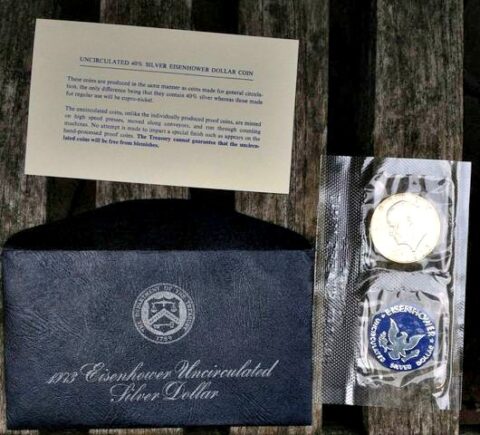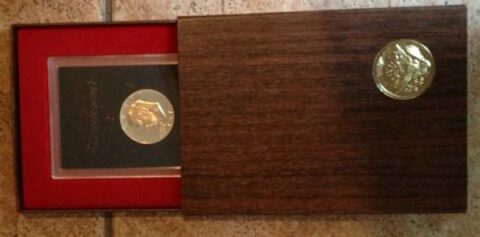Blue Ikes and Brown Ikes are 2 different types of Eisenhower dollar coins.
They have been the darlings of many modern dollar coin collectors since the release of these 2 coins in 1971.
That was the year that the United States Mint released the first dollar coins since the Peace dollar series ceased production in 1935.
Unlike silver dollars of yesteryear, regular-strike Eisenhower dollars contain no silver at all.
That is where Blue Ike dollar coins and Brown Ike dollar coins come in.
The Story Behind Blue Ikes & Brown Ikes
These 2 types of Eisenhower dollars are made of 40% silver.
Blue Ike dollar coins and Brown Ike dollar coins were struck primarily for coin collectors and were sold directly by the U.S. Mint.
Why were they made?
Well, the U.S. Mint made silver Eisenhower dollars strictly for collectors to avoid the hoarding of Kennedy half dollars.
NOTE: Collectors love the Kennedy half dollar, featuring the beloved president, and Americans tucked away Kennedy half dollars as soon as they hit circulation to keep a memento of JFK. The Kennedy half dollar, as a denomination, failed to circulate well afterward and today has virtually vanished from circulation.
But, getting back to Eisenhower dollars, what exactly is a Blue Ike? Or a Brown Ike?
How are they different, how many were made, and what are they worth?
Key Differences Between Blue Ikes & Brown Ikes
Blue Ike dollar coins and Brown Ike dollar coins were struck at the San Francisco mint.
They were made from 1971 through 1974.
All Eisenhower dollars which were struck from 1971 through 1978 were designed by Frank Gasparro.
Blue Ikes were struck as uncirculated coins. They were housed in a cellophane package that contained a blue and silver token emblazoned with a U.S. Mint logo.
Brown Ikes are proof versions of the 40% silver Eisenhower dollar. They were packaged in a hard, rectangular plastic case that was packed inside a faux-woodgrain box bearing a gold eagle seal.
It is interesting to note that the original sale price for Blue Ikes was $3, while Brown Ikes originally cost $10.
How Many Blue & Brown Eisenhower Dollars Were Made?
Mintages of Blue Ikes and Brown Ikes were quite limited, compared to the number of Eisenhower dollar coins struck for general use in circulation.
While tens of millions of Eisenhower dollars were made for each date-and-mintmark combination, only a fraction thereof were made for each date of the 40% silver Eisenhower dollar coins.
Here are the mintage numbers for Blue Ike dollar coins and Brown Ike dollar coins:
- 1971-S Blue Ike – 6,868,530
- 1971-S Brown Ike – 4,265,234
- 1972-S Blue Ike – 2,193,056
- 1972-S Brown Ike – 1,811,631
- 1973-S Blue Ike – 1,883,140
- 1973-S Brown Ike – 1,013,646
- 1974-S Blue Ike – 1,900,156
- 1974-S Brown Ike – 1,306,579
How Much Are Blue Ikes And Brown Ikes Worth?
The values for these 40% silver Eisenhower dollars have changed much over the years.
For example, at one point around 1980, a 1973-S Brown Ike, which had a mintage of barely more than 1 million pieces, would’ve set you back over $100. Today, the same piece can be had for as little as $20 to $25.
Here are the approximate values of Blue Eisenhower dollars and Brown Eisenhower dollars:
- 1971-S Blue Ike – $12
- 1971-S Brown Ike – $17
- 1972-S Blue Ike – $12
- 1972-S Brown Ike – $16
- 1973-S Blue Ike – $12
- 1973-S Brown Ike – $22
- 1974-S Blue Ike – $12
- 1974-S Brown Ike – $17
Like all silver coins, Blue Ikes and Brown Ikes will fluctuate in value and may therefore be worth more or less than the values shown here — which are based on silver being worth $20 per ounce.
Tips For Collecting Blue & Brown Eisenhower Dollar Coins
In general, coin collectors prefer Blue and Brown Eisenhower dollars in their original packaging.
But, for the most part, they are worth about the same if removed from the cases as if they are left in.
Many coin collectors remove silver Eisenhower dollars from their packaging to be placed into coin albums — such as those that house complete date-and-mintmark sets of the dollar coin.







